Pizza sauce is a crucial component that can greatly impact the calorie content of your favorite dish. Whether you’re a pizza lover or simply watching your calorie intake, being mindful of the calories in pizza sauce can help you make smart eating choices without sacrificing deliciousness.
Counting pizza sauce calories doesn’t mean you have to give up on enjoying this beloved comfort food. With the right choices, you can still savor every bite while keeping an eye on your calorie intake.
Key Takeaways:
- Knowing the calorie content of pizza sauce is important for making mindful eating choices.
- Low-calorie pizza sauce options are available, both store-bought and homemade.
- Creating a healthier pizza involves using low-calorie crust options, such as whole wheat or gluten-free.
- Choosing nutritious toppings, such as lean proteins and abundant vegetables, can enhance the healthiness of your pizza.
- Proper storage and reheating techniques are essential for maintaining food safety when enjoying leftover pizza.
Understanding Pizza Sauce Calories and Nutritional Information
Knowing the calorie content and nutritional information of pizza sauce can help you make informed choices about your pizza consumption. Pizza sauce is a key ingredient that contributes to the overall calorie count of a pizza. By understanding its nutritional composition, you can opt for healthier alternatives and create a deliciously smart pizza.
Pizza sauce varies in calorie content depending on factors such as the brand, recipe, and serving size. Generally, a 1/4-cup (61g) serving of pizza sauce contains around 40-60 calories. It is essential to check the nutrition facts label on store-bought pizza sauces to determine their specific calorie content.
When making homemade pizza sauce, you have more control over the ingredients and can tailor it to your dietary needs. A simple homemade sauce can be made with crushed tomatoes, garlic, herbs, and spices, without adding any extra calories. This allows you to enjoy the rich flavors of pizza sauce while keeping the calorie count in check. Plus, homemade sauce can be a healthier alternative to store-bought options that may contain added sugars or preservatives.
| Serving Size | Calories |
|---|---|
| Store-Bought Pizza Sauce (1/4 cup) | 40-60 |
| Homemade Pizza Sauce (1/4 cup) | Calorie-free |
By being mindful of the calorie content of pizza sauce and opting for healthier alternatives like homemade sauce or low-calorie store-bought options, you can enjoy pizza without compromising your calorie goals. Pairing it with a healthier crust, nutritious toppings, and thoughtful portion sizes can further enhance the nutritional value of your homemade pizza. So go ahead, count those pizza sauce calories and embark on a deliciously smart pizza journey!
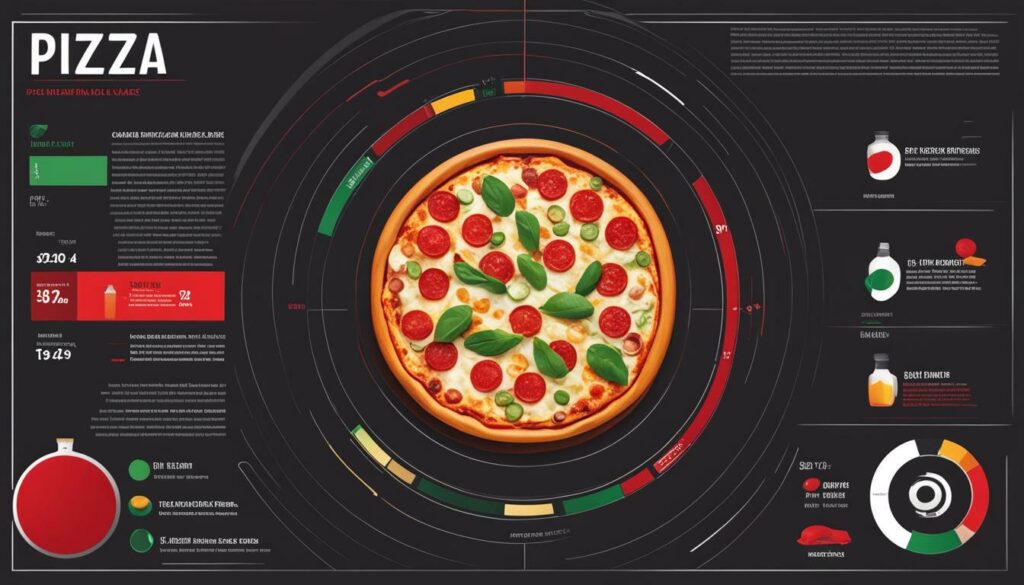
If you’re watching your calorie intake, there are several low-calorie pizza sauce options available that can still satisfy your taste buds. By choosing a healthier sauce alternative, you can enjoy a delicious pizza without compromising on flavor or your dietary goals. Here are some low calorie pizza sauce options to consider:
1. Homemade Tomato Sauce: Making your own pizza sauce allows you to control the ingredients and reduce the calorie content. You can use fresh tomatoes, herbs, and spices to create a flavorful sauce that is low in calories. Plus, it’s a great way to add a personal touch to your pizza creation.
2. Marinara Sauce: Marinara sauce is another excellent low-calorie option for pizza. It is typically made with tomatoes, garlic, onions, and herbs. Look for a marinara sauce that is low in added sugars and oils to keep the calorie count down. You can also make your own marinara sauce at home to ensure it meets your dietary needs.
Comparing Low Calorie Pizza Sauce Options
| Pizza Sauce | Calories per serving (1/4 cup) | Sugar (g) | Sodium (mg) | Ingredients |
|---|---|---|---|---|
| Homemade Tomato Sauce | 32 | 4 | 220 | Tomatoes, onions, garlic, herbs, spices |
| Store-Bought Marinara Sauce | 40 | 6 | 400 | Tomatoes, onions, garlic, herbs, spices |
When choosing a low-calorie pizza sauce, be sure to read the nutritional information and ingredient list. Look for sauces that are low in calories, added sugars, and sodium. Opting for homemade sauces or those made with whole, natural ingredients will help you create a healthier pizza without sacrificing taste.
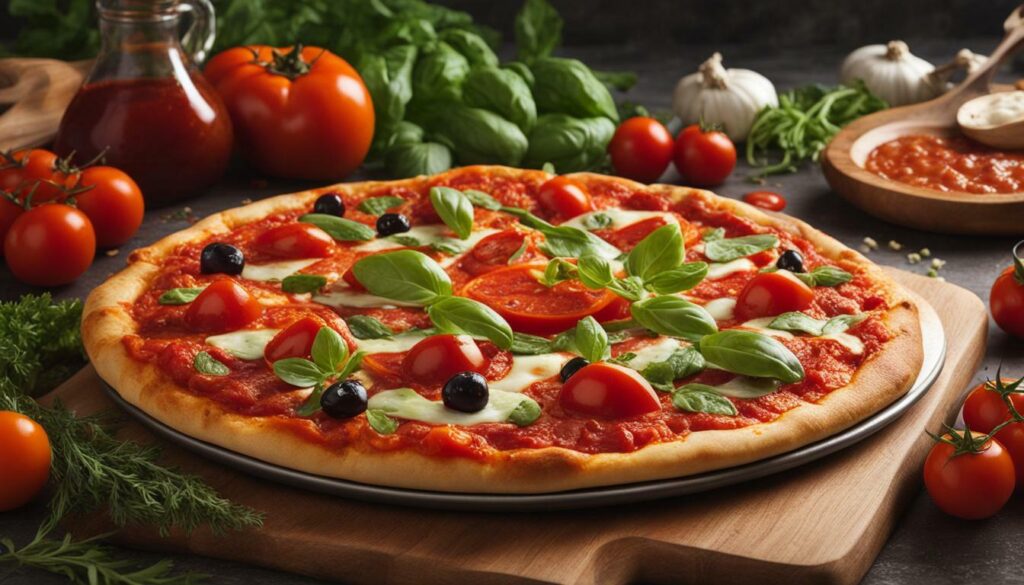
Remember, pizza can still be a part of a balanced and nutritious diet. By selecting low-calorie sauce options and pairing them with a healthier crust and toppings, you can enjoy a delicious pizza without guilt. So go ahead and get creative with your pizza creations while keeping your calorie intake in check!
Homemade Pizza Sauce Calories and Ingredients
Making your own pizza sauce allows you to customize the ingredients and control the calorie count to suit your dietary preferences. By using fresh, wholesome ingredients, you can create a delicious sauce that is both flavorful and nutritious. Let’s take a closer look at the calorie content and ingredients commonly used in homemade pizza sauce.
A basic homemade pizza sauce typically includes crushed tomatoes, garlic, olive oil, and a blend of herbs and spices. This combination adds depth and richness to the sauce without adding excessive calories. A quarter-cup serving of homemade pizza sauce contains approximately 35 calories, making it a lower-calorie option compared to store-bought sauces.
One of the benefits of making your own pizza sauce is the ability to adjust the ingredients to your liking. You can easily add more garlic for extra flavor or reduce the amount of olive oil for a lighter sauce. Controlling the ingredients allows you to avoid unnecessary additives or preservatives often found in store-bought sauces.
| Ingredient | Calories (per serving) |
|---|---|
| Crushed Tomatoes (1/4 cup) | 20 |
| Garlic (1 clove) | 4 |
| Olive Oil (1 teaspoon) | 40 |
| Herbs and Spices (to taste) | Approximately 0 |
As shown in the table above, the calorie content of homemade pizza sauce primarily comes from the olive oil, which provides healthy fats. By using a modest amount, you can still enjoy the flavor without significantly increasing the calorie count. Remember that portion control plays a crucial role in managing calorie intake, so be mindful of the amount of sauce you use on your pizza.
Creating your own homemade pizza sauce not only allows you to control the calorie count but also gives you the opportunity to experiment with different flavors and tailor the sauce to your preferences. With a little creativity and the right ingredients, you can enjoy a delicious pizza while keeping your calorie intake in check.
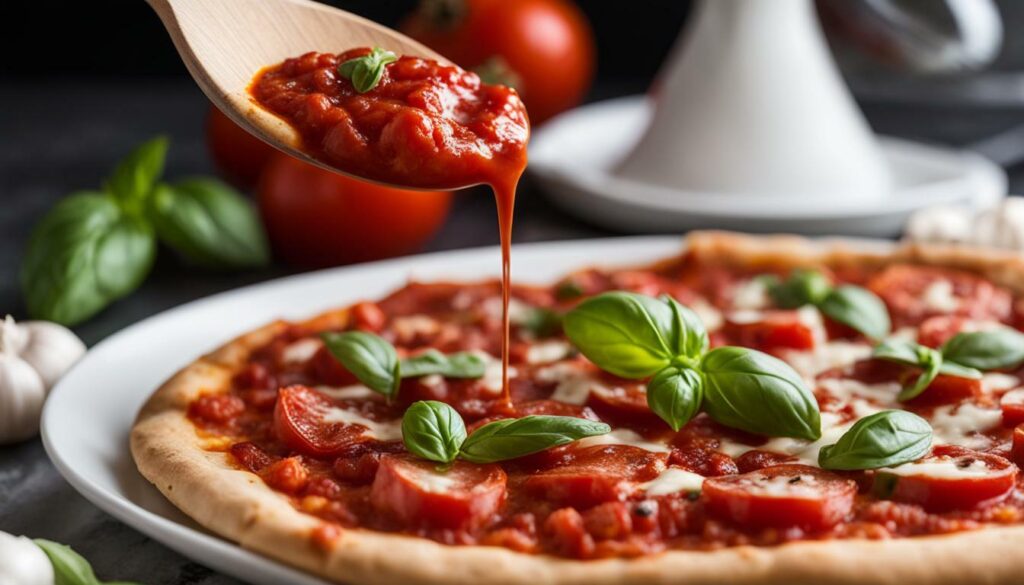
A deliciously healthy pizza starts with a crust that aligns with your dietary needs, whether you’re looking for a low-calorie option, whole grains, or avoiding gluten and animal products. By choosing the right crust, you can enjoy a guilt-free slice without sacrificing flavor.
If you’re aiming for a low-calorie pizza, consider using a crust made from just two ingredients – self-rising flour and non-fat yogurt. This simple recipe yields a crust with just 55 calories per slice or under 400 calories for the entire pizza. It’s a great option for those watching their calorie intake but still craving the taste of a classic slice.
| Crust Option | Calories per Slice | Additional Benefits |
|---|---|---|
| Low-Calorie Crust | 55 | Simple and low in calories |
| Whole Wheat Crust | 90 | Rich in dietary fiber and nutrients |
| Gluten-Free Crust | 110 | Suitable for individuals with gluten intolerance |
| Vegan Crust | 80 | Free from animal products |
To add more nutritional value and flavor to your pizza, consider opting for a whole wheat crust. It offers the goodness of whole grains, providing dietary fiber and essential nutrients. If you have gluten intolerance, a gluten-free crust is a great alternative, offering a crust that is safe for consumption without compromising taste. For those following a vegan diet, a vegan crust made with plant-based ingredients is a satisfying choice.
Achieving a healthier pizza is all about making smart choices, and the crust is just the beginning. Combine your preferred crust with a variety of delicious veggies, lean proteins, and low-fat cheese to create a well-balanced and nutritious pizza that suits your tastes and dietary goals.
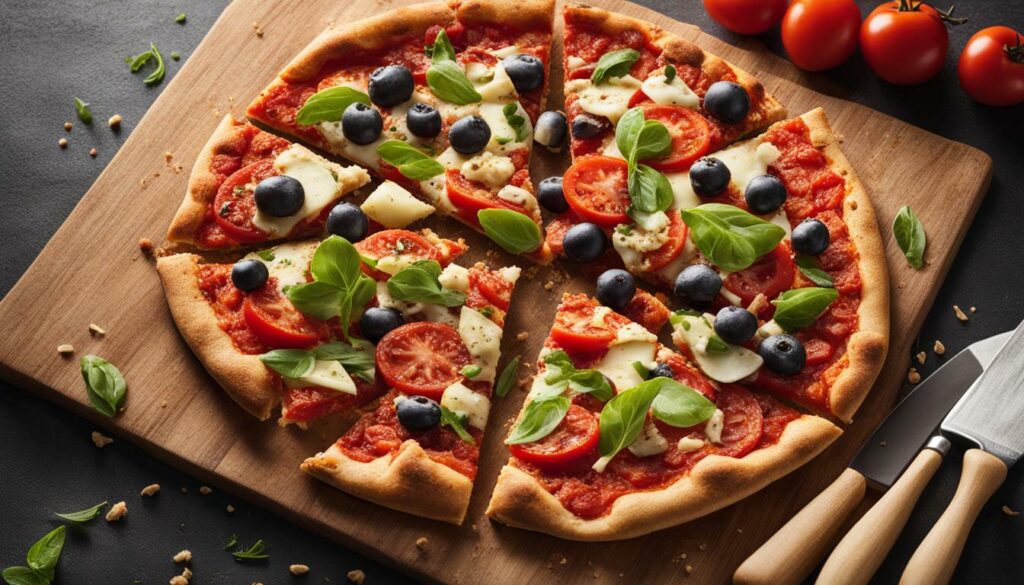
Remember, creating a healthier pizza at home allows you to take control of the ingredients and portion sizes. By counting pizza sauce calories and implementing smart choices, you can enjoy your favorite dish guilt-free and ensure it aligns with your dietary needs.
Customizing Pizza Toppings for Healthier Choices
Toppings are where you can get creative and incorporate nutritious ingredients to make your pizza a healthier and satisfying meal. By choosing the right toppings, you can add flavor and texture while keeping the calorie count in check. Here are some ideas for healthier pizza toppings:
- Lean Proteins: Instead of fatty meats like sausage or bacon, opt for lean proteins such as grilled chicken, turkey breast, or even tofu for a vegetarian option. These protein sources are lower in fat and can provide the same level of satisfaction.
- Vegetables: Load up your pizza with an assortment of colorful vegetables. Bell peppers, mushrooms, spinach, onions, and cherry tomatoes are just a few options to consider. Not only do they add flavor and texture, but they also provide important vitamins and minerals.
- Low-Fat Cheese: Choose low-fat or part-skim cheese options instead of full-fat varieties. This will help reduce the calorie and fat content of your pizza while still providing that cheesy goodness we all love.
- Turkey Pepperoni: If you can’t resist the classic pepperoni flavor, opt for turkey pepperoni instead. It’s leaner and lower in fat compared to traditional pork pepperoni, making it a healthier choice.
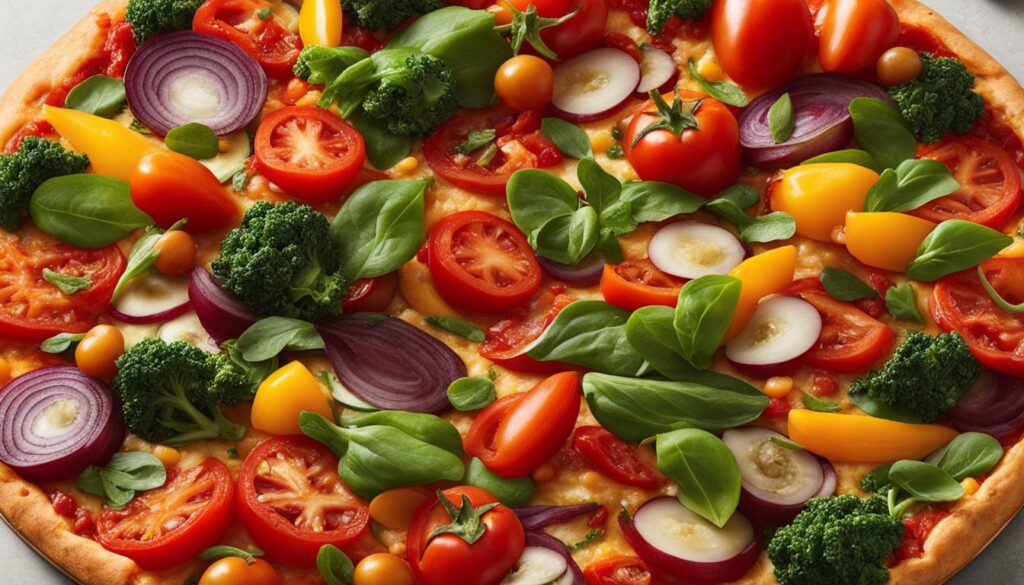
“Customizing your pizza toppings is a great way to make healthier choices without sacrificing taste. Adding lean proteins, an array of vegetables, and opting for low-fat cheese and turkey pepperoni can significantly reduce the calorie content while still creating a delicious and satisfying meal.”
Healthy Pizza Recipe with Flatbread Crust
If you’re looking for a lighter alternative, consider using a light flatbread as your crust. This creates a thin and crispy base that pairs well with a variety of toppings. Here’s a simple recipe to get you started:
| Ingredients: | Calories per Serving: |
|---|---|
| 1 light flatbread crust | 80 |
| 1/4 cup pizza sauce | 20 |
| 1/4 cup part-skim mozzarella cheese | 80 |
| Assorted vegetables (e.g. bell peppers, mushrooms, onions) | Varies |
| Grilled chicken or turkey pepperoni | Varies |
Preheat your oven to 425°F (220°C). Place the flatbread on a baking sheet and spread the pizza sauce evenly. Sprinkle the cheese over the sauce, followed by the vegetables and your choice of protein. Bake in the oven for 10-12 minutes or until the cheese is melted and the crust is golden brown. Slice and enjoy!
Whether you choose to make your own crust or use a store-bought option, customizing your pizza toppings with healthy choices can transform this indulgent food into a satisfying and guilt-free meal. Remember to be mindful of portion sizes and moderation to maintain a balanced diet. Enjoy your delicious and nutritious pizza!
Calculating Calories in a Slice of Regular Cheese Pizza
When dining out or ordering pizza delivery, it’s important to be aware of the calorie content in a slice of regular cheese pizza. A standard slice from a fast-food chain contains around 285 calories and 35.6 grams of carbs. These numbers can quickly add up if you’re not mindful of your portion sizes.
To put it into perspective, imagine enjoying two slices of regular cheese pizza along with a soft drink. That’s roughly 570 calories consumed in just one meal. If you’re watching your calorie intake or trying to maintain a balanced diet, this can be a significant chunk of your daily allowance.
Creating a healthier pizza option at home can help you enjoy this beloved dish without the guilt. By making conscious choices in the ingredients and portion sizes, you can recreate a delicious pizza that aligns with your dietary goals.
| Toppings | Calories per Serving |
|---|---|
| Regular Crust with Cheese and Pepperoni | 285 calories |
| Homemade Whole Wheat Crust with Low-fat Cheese and Turkey Pepperoni | 200 calories |
| Light Flatbread Crust with Abundant Vegetables and Low-fat Cheese | 150 calories |
As you can see, making simple swaps and adjustments can significantly reduce the calorie content of your pizza. By opting for a homemade whole wheat crust with healthier toppings like lean proteins and vegetables, you can enjoy a satisfying slice with fewer calories.
Remember, a slice of regular cheese pizza is not forbidden, but being mindful of your choices and portion sizes can make a difference in achieving a balanced diet. By counting pizza sauce calories and making smart choices, you can indulge in this delicious dish while staying on track with your health and wellness goals.
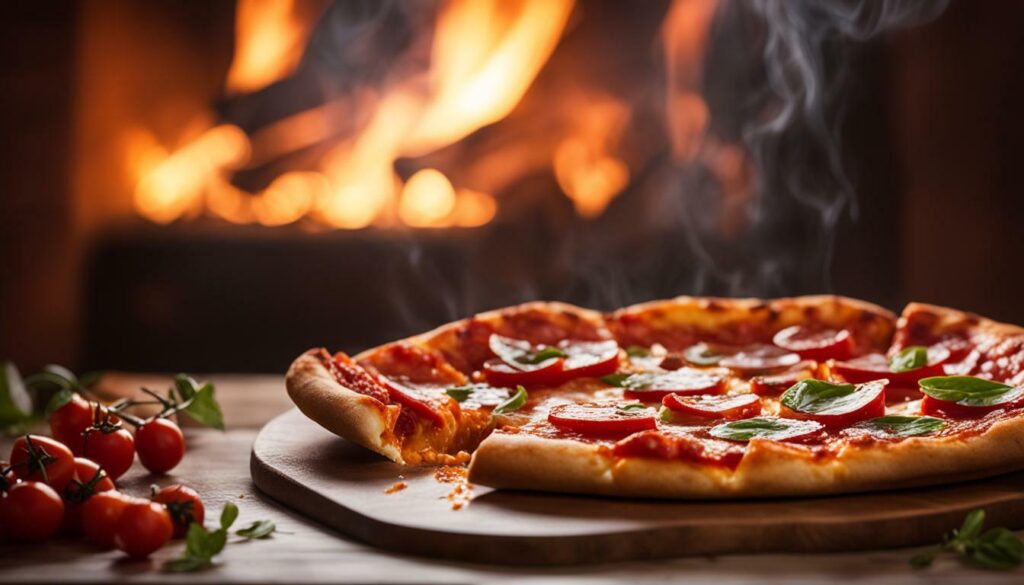
By putting together the right ingredients and following a few simple tips, you can enjoy a healthy and satisfying homemade pizza. One great option is a low-calorie pizza recipe that features a crust made with just two ingredients: self-rising flour and non-fat yogurt. This combination creates a light and crispy crust with only 55 calories per slice or under 400 calories for the entire pizza.
To enhance the nutritional value of your homemade pizza, you can customize the toppings. Opt for low-fat cheese, which is lower in calories and saturated fat compared to regular cheese. Turkey pepperoni is a flavorful and lean protein option that can be used instead of traditional pepperoni. Load up your pizza with a variety of vegetables to add fiber, vitamins, and minerals.
Another option for a healthier pizza is to use a light flatbread crust. This type of crust is typically lower in calories and carbohydrates compared to traditional pizza dough. You can pile on as many delicious veggies as you like to create a filling and nutritious meal.
When making a homemade pizza, it’s also important to consider dietary restrictions or preferences. If you or your guests have gluten sensitivities, you can use a gluten-free crust or opt for a cauliflower crust, which has gained popularity in recent years. For those following a vegan diet, there are plenty of plant-based cheese alternatives and toppings that can be used to create a delicious vegan pizza.

| Topping | Calories per Serving | Fat (g) | Carbs (g) | Protein (g) |
|---|---|---|---|---|
| Low-fat cheese | 50 | 3 | 1 | 5 |
| Turkey pepperoni | 70 | 3.5 | 1 | 9 |
| Assorted vegetables | Varies | Varies | Varies | Varies |
Creating a healthy pizza at home allows you to control the ingredients and make choices that align with your dietary goals. Whether you’re looking to reduce calories, increase nutrient content, or cater to specific dietary needs, homemade pizza offers endless possibilities. So, grab your apron, get creative, and enjoy a delicious and nourishing homemade pizza.
Storing and Reheating Pizza for Food Safety
Properly storing and reheating pizza is essential to ensure both food safety and the best possible flavor. Whether you have leftover pizza or want to prepare ahead of time, following the correct methods will help maintain the quality of the pizza and prevent any potential health risks.
Storing Pizza
When storing pizza, it’s crucial to keep it in the refrigerator to prevent bacterial growth. Place the leftover slices in an airtight container or cover them tightly with plastic wrap. This will help retain moisture and prevent the pizza from drying out.
It’s important to consume refrigerated pizza within 3-4 days to ensure freshness. If you’re not planning to eat it within this timeframe, you can also freeze the slices. Wrap each slice individually in plastic wrap or aluminum foil and store them in a freezer-safe bag. Frozen pizza can last up to 2-3 months, although for the best quality, it’s recommended to consume it within 1-2 months.
Reheating Pizza
When reheating pizza, the goal is to achieve a crispy crust while ensuring the toppings are heated through. There are several methods you can use:
- 1. Oven: Preheat your oven to around 375°F (190°C). Place the pizza directly on the oven rack or on a baking sheet. Bake for about 10-12 minutes or until the cheese is melted and the crust is crispy.
- 2. Skillet: Heat a skillet over medium-low heat. Place the pizza slice(s) in the skillet and cover with a lid. Cook for about 5-7 minutes or until the cheese has melted and the crust is crispy.
- 3. Microwave: This method is quick but may result in a softer crust. Place the pizza slice(s) on a microwave-safe plate and cover with a microwave-safe cover or microwave-safe paper towel. Heat on high for about 30 seconds to 1 minute per slice, or until the cheese is melted.
Food Safety Tips
Here are some additional food safety tips to keep in mind when handling and reheating pizza:
- Always wash your hands before and after handling pizza to prevent the spread of bacteria.
- Reheated pizza should reach an internal temperature of 165°F (74°C) to ensure any potential bacteria are killed.
- Avoid leaving pizza at room temperature for more than 2 hours, as bacteria can multiply rapidly in the “danger zone” between 40°F (4°C) and 140°F (60°C).
By storing and reheating pizza properly, you can enjoy its delicious flavors while minimizing the risk of foodborne illnesses. Remember to follow these guidelines for food safety and savor your pizza without any concerns!
| Pizza Storage | Pizza Reheating |
|---|---|
| Refrigerate leftover pizza in an airtight container or tightly wrapped in plastic wrap. | Bake in the oven at 375°F (190°C) for 10-12 minutes or until cheese is melted and crust is crispy. |
| Consume refrigerated pizza within 3-4 days or freeze for up to 2-3 months. | Heat in a skillet over medium-low heat with a lid for 5-7 minutes. |
| Avoid leaving pizza at room temperature for more than 2 hours to prevent bacterial growth. | Microwave on high for 30 seconds to 1 minute per slice or until cheese is melted. |
Considering Dietary Restrictions and Preferences
If you have specific dietary restrictions or preferences, there are still delicious pizza options available that cater to your needs. Whether you follow a gluten-free or vegan diet, you can enjoy a slice of pizza without compromising on taste or nutrition.
For those who are gluten-free, there are several alternatives to traditional pizza crust. Try opting for a gluten-free crust made with ingredients like almond flour, tapioca starch, or cauliflower. These crusts provide a tasty and satisfying base for your pizza, while still adhering to your dietary restrictions.
If you follow a vegan diet, you can choose from a variety of plant-based toppings and cheeses to create a flavorful and indulgent pizza. Load up your pizza with vibrant vegetables like bell peppers, mushrooms, and spinach. For added protein, consider using ingredients like tofu, tempeh, or plant-based sausage.
| Dietary Restrictions | Pizza Options |
|---|---|
| Gluten-free | Gluten-free crust made with almond flour, tapioca starch, or cauliflower |
| Vegan | Plant-based toppings and cheeses, tofu, tempeh, or plant-based sausage |
No matter your dietary needs, it’s important to remember that pizza can still be a delicious and satisfying option. By choosing the right ingredients and customizing your toppings, you can create a pizza that not only meets your dietary restrictions but also pleases your taste buds.
So, the next time you’re craving a slice of pizza, don’t let your dietary restrictions hold you back. Explore the wide range of options available and indulge in a pizza that is both flavorful and tailored to your needs.
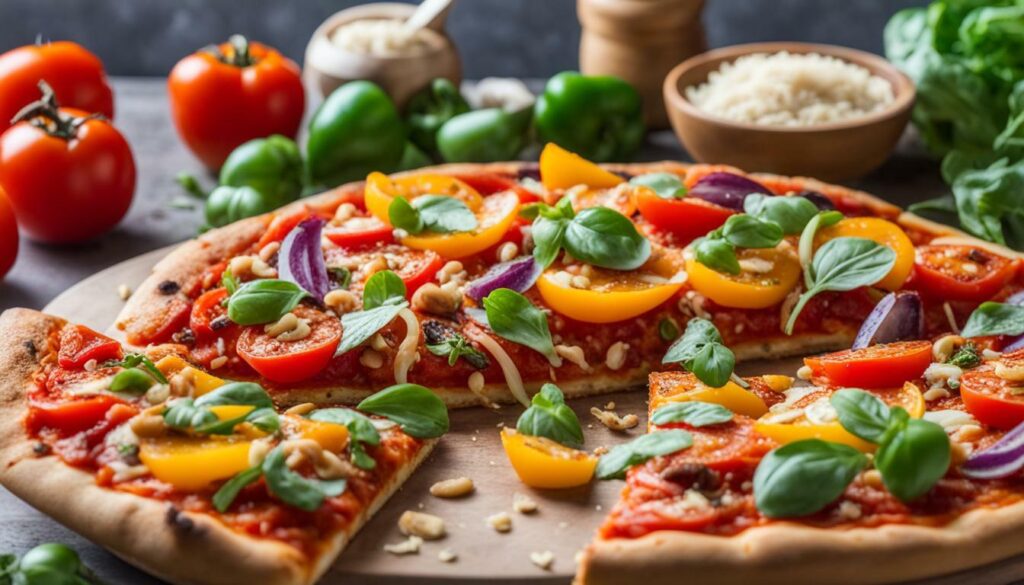
The Benefits of Counting Pizza Sauce Calories and Making Smart Choices
Counting pizza sauce calories and making mindful choices can lead to a healthier and more enjoyable pizza experience. By being conscious of the calorie content in pizza sauce, you can create a delicious pizza that aligns with your dietary goals. Whether you’re trying to maintain a healthy weight or simply make smarter eating choices, understanding the nutritional information of the sauce is essential.
One of the key benefits of counting pizza sauce calories is the ability to customize your pizza to fit your specific dietary needs. By opting for low-calorie sauce options, you can significantly reduce the overall calorie count of your pizza without compromising on taste. There are various store-bought and homemade options available that offer a flavorful experience while keeping the calorie content in check.
Additionally, by making smart choices when it comes to the crust and toppings, you can create a well-rounded and satisfying pizza. Using healthier crust alternatives, such as whole wheat or gluten-free options, provides added dietary fiber and can support your nutritional goals. Topping your pizza with lean proteins, abundant vegetables, and low-fat cheese further enhances the nutritional value of your meal.
Remember, making a homemade pizza allows you complete control over the ingredients and portion sizes, ensuring you create a healthier option. By considering your dietary restrictions and preferences, such as gluten-free or vegan choices, you can personalize your pizza to suit your needs. Whether you’re counting calories or simply striving for a more balanced meal, being mindful of pizza sauce calories and making smart choices can help you savor every bite guilt-free.
By being conscious of the calorie content in pizza sauce and making smart choices, you can enjoy pizza without compromising your healthy eating goals. Counting pizza sauce calories can be a deliciously smart choice for those watching their calorie intake. One low-calorie pizza recipe offers a crust made with just two ingredients, self-rising flour and non-fat yogurt, and a homemade calorie-free sauce. The recipe yields a crust with just 55 calories per slice or under 400 calories for the entire pizza.
Toppings can be customized to include low-fat cheese, turkey pepperoni, and various vegetables. Additionally, a healthy pizza recipe using a light flatbread crust is suggested, with options to add as many delicious veggies as desired. A standard slice of regular cheese pizza from a fast-food chain contains around 285 calories and 35.6 grams of carbs.
Making healthy, satisfying pizza at home can involve using whole wheat crust for added dietary fiber, opting for healthier toppings like vegetables and lean proteins, and considering gluten-free or vegan options. It is important to store and reheat pizza properly to ensure food safety.
Overall, counting pizza sauce calories and making smart choices when it comes to ingredients and portion sizes can help create a healthier pizza option. By being mindful of your choices, you can still indulge in the deliciousness of pizza while maintaining a balanced and nutritious diet.
FAQ
Q: How many calories are in pizza sauce?
A: The number of calories in pizza sauce can vary depending on the brand and recipe. It’s important to check the nutrition label or calculate the calories based on the ingredients used.
Q: What is the nutritional information for pizza sauce?
A: Pizza sauce typically contains tomatoes, herbs, and spices. It is generally low in calories and fat, but can vary in sodium content. It’s always a good idea to check the nutrition label for specific information.
Q: What are some low-calorie pizza sauce options?
A: There are several low-calorie pizza sauce options available, including store-bought brands that offer reduced-fat or reduced-sugar options. You can also make your own sauce using fresh tomatoes and herbs to control the calorie content.
Q: How many calories are in homemade pizza sauce?
A: Homemade pizza sauce can vary in calorie content depending on the ingredients used. However, by using fresh tomatoes, herbs, and spices, you can create a low-calorie sauce option.
Q: What are some healthier pizza crust options?
A: Healthier pizza crust options include whole wheat crust, gluten-free crust, and even cauliflower crust. These alternatives offer more fiber and nutrients compared to traditional white flour crusts.
Q: What are some healthy pizza toppings?
A: Healthy pizza toppings include an abundance of vegetables, lean proteins like grilled chicken or turkey, low-fat cheese, and turkey pepperoni. These choices add flavor and nutrition without adding excessive calories.
Q: How many calories are in a slice of regular cheese pizza?
A: A standard slice of regular cheese pizza from a fast-food chain contains around 285 calories. By making your own pizza at home with healthier ingredients, you can significantly reduce the calorie content.
Q: How can I create a healthy pizza at home?
A: To create a healthy pizza at home, use low-calorie sauce, healthier crust options like whole wheat or cauliflower, and load up on nutritious toppings like vegetables and lean proteins. This allows you to enjoy pizza guilt-free.
Q: How should I store and reheat pizza for food safety?
A: Leftover pizza should be stored in an airtight container in the refrigerator. To reheat, use a preheated oven or toaster oven for the best results. Avoid reheating pizza in the microwave as it can make the crust soggy.
Q: What are some options for gluten-free or vegan pizza?
A: For those with dietary restrictions, gluten-free crust options using alternative flours like rice or almond flour are available. Vegan pizza can be made using dairy-free cheese alternatives and a variety of vegetable toppings.
Q: What are the benefits of counting pizza sauce calories?
A: Counting pizza sauce calories allows you to make informed choices about your calorie intake. By understanding the calorie content of different ingredients, you can create a healthier pizza option that still satisfies your cravings.
What Are Some Healthy Veggie Wrap Recipes That Can Help with Counting Calories?
Looking for a delicious veggie wrap recipe to satisfy your taste buds while watching your calorie intake? Look no further! Whip up a mouthwatering Mediterranean-inspired wrap with grilled vegetables, feta cheese, and a zesty homemade vinaigrette. Or try a refreshing Asian-inspired option filled with crunchy veggies, tofu, and a tangy peanut sauce.

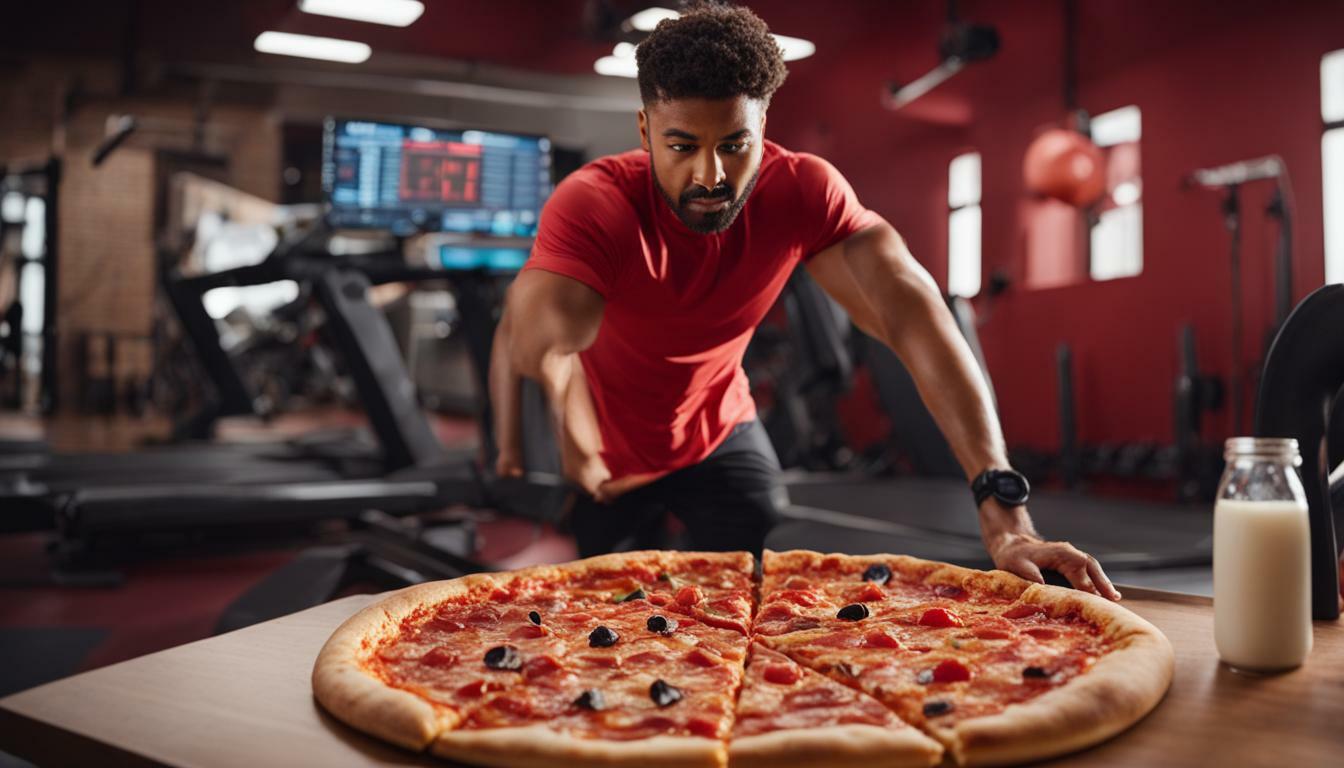



Leave a Reply